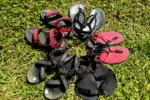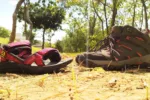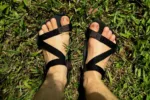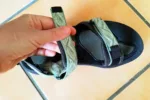Barefoot Sandals for Hiking & 5 Reasons they are the Best
This post may contain affiliate links. This means that we may receive a small commission from purchases through those links. Read more in our affiliate disclosure.
I became a big fan of barefoot sandals for hiking, running, and everything else a few years ago, after they single-handedly (footedly?) solved the joint problems I used to have. And now I’d love to share that experience with you!
Barefoot sandals are designed to allow your feet to move naturally, as if you were barefoot. They ideally have flexible, zero-drop, and uncushioned soles that are able to move with your foot through an excellent fit, allow for wide feet, and are lightweight. This allows you to adopt a more natural gait, lets you move more efficiently, and make full use of your foot’s anatomy to absorb the impact of every step, while likely avoiding a host of potential foot issues such as flat feet, hallus valgus, and more. Transitioning to barefoot sandals should be done gradually to avoid over-training. Start with short walks and gradually increase the distance as your feet adapt.
Read on, or check out my recommendations for my favourite hiking sandals!
Disclaimer – I’m not a doctor, just someone with feet and sandals and a bunch of personal experince with both. Take advice with an according amount of salt.
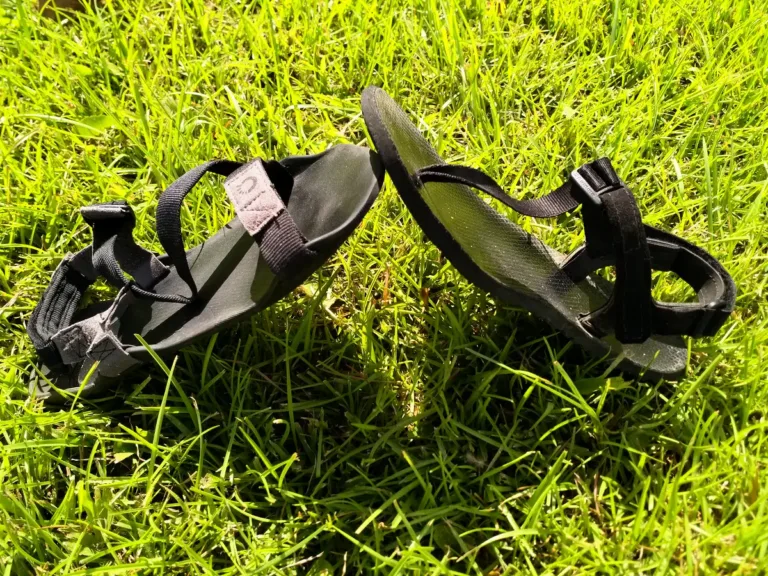
Barefoot sandals changed the way I hike. I’d love to share my journey and insights with you, so you too can experience the joy and freedom of barefoot sandals too!
- Introduction
- What are barefoot sandals?
- Are humans meant to be barefoot?
- My story
- What makes a good barefoot sandal?
- Are barefoot sandals good for you? Pros and Cons.
- Are zero drop sandals good for your knees?
- Are barefoot sandals good for foot health?
- Can walking barefoot improve posture?
- Is walking barefoot better than sandals?
- How to transition to barefoot sandals
- FAQs
- Can you use flip flops as barefoot sandals?
- Can I wear barefoot sandals for running?
- Are barefoot sandals suitable for all terrains?
- Can I wear socks with barefoot sandals?
- How do I clean my barefoot sandals?
- How often should I replace my barefoot sandals?
- Conclusion
What are barefoot sandals?
Barefoot sandals, also often called minimalist sandals, are designed to mimic the experience of walking barefoot while providing some level of protection for your feet. They allow your feet to move and function as if you were barefoot, or at least as close to it as possible when compared to standard footwear.
The term “barefoot sandals” can be interpreted in several ways. At one end of the spectrum, we have what are essentially “pretend sandals“: These are minimalist designs that, at a glance, look like sandals but leave your soles completely uncovered, protecting you from social pressure (and nothing else). They are a cool idea and I might give them a try at some point, but they are not the focus of our discussion today.
Instead, we are going to focus on actual hiking sandals that offer some level of protection from the elements and rough terrain while still allowing it to move naturally.
Barefoot sandals come with a host of benefits. They allow you to feel the ground beneath your feet, which can help improve your balance and proprioception. This ability to feel and adapt to the ground can be particularly beneficial when hiking on uneven terrain.
Another key benefit of barefoot sandals is that they promote a natural gait. Traditional footwear often alters the way we walk, leading to a host of potential issues. Barefoot sandals, on the other hand, allow your foot to move as it has evolved to, which can lead to improved foot health and overall biomechanics.
Finally, walking in barefoot sandals strengthens your feet. Traditional shoes often provide so much support and cushioning that the muscles in our feet don’t have to work as hard and ultimately atrophy. Barefoot sandals, on the other hand, make you actively use all your feet muscles, which helps strengthen them over time.
Are humans meant to be barefoot?
A lot of the knowledge in this article are lessions I learned from the fascinating book “Born to Run”, which explores the history and benefits of barefoot running. I read it a few years ago and it completely changed the way I think about running and footwear. I highly recommend you check it out!
One of the key takeaways from the book is that the human foot is naturally designed for barefoot walking and running. Our ancestors spent thousands of years walking and running barefoot, and our feet evolved to be perfectly suited to this task. The complex structure of our feet, with its 26 bones, 33 joints, and over 100 muscles, tendons, and ligaments, is incredibly well-adapted to barefoot movement.
However, the advent of modern footwear has had a significant impact on foot health and gait. Traditional shoes often provide so much support and cushioning that our feet don’t have to work as hard, which can lead to weaker foot muscles. Furthermore, many shoes have a raised heel and narrow toe box, which can alter our natural gait, force the shape of your feet to change, and lead to a host of potential issues.
Natural feet, that have never been restrained by modern shoes, are quite strong and wide:
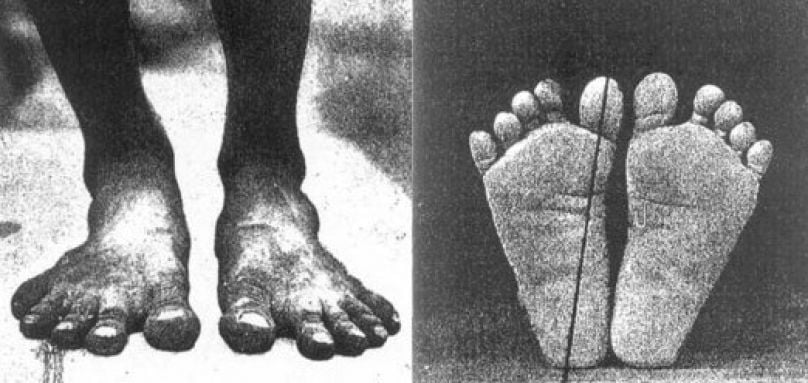
On the other hand, if you constantly wear the same restrictive shoes, your feet will take the shape of those shoes:
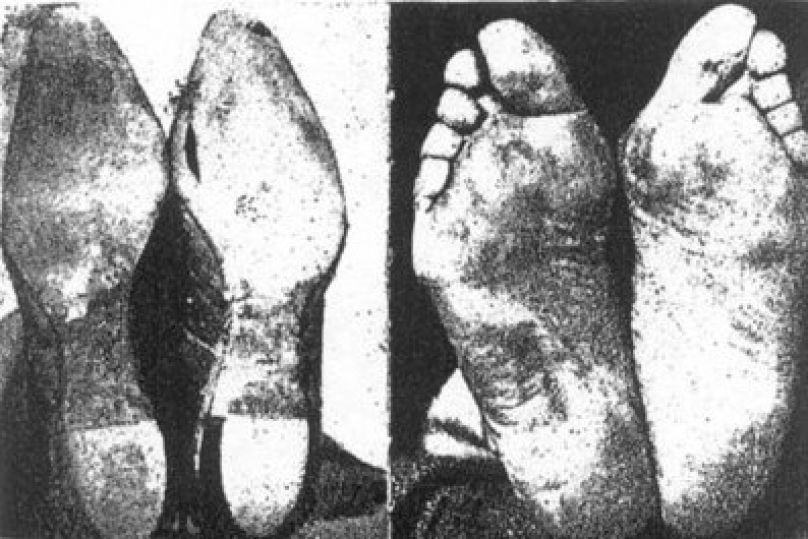
There has been a resurgence of barefoot walking and running in recent years. More and more people are rediscovering the benefits of letting their feet move naturally. This movement is not just limited to running, but also extends to walking and hiking.
Based on my personal experience, I firmly believe that there are significant benefits to be gained from walking and hiking barefoot or in barefoot sandals or barefoot running shoes. The natural movement patterns promoted by barefoot walking can lead to improved foot health, a more natural gait, and stronger feet.
My story
In my early twenties, I had a massive problem with my joints. Running as little as 3 km would leave my joints feeling like they were filled with sand for the next couple of days. No matter how much I invested in fancy well-cushioned running shoes and inlays, the problem persisted.
One doctor suggested this might all be caused by my legs having different lengths, and that I should wear custom shoes with different thickness soles. “But they don’t make running shoes like that, do they?” I asked. “Then maybe you shouldn’t be running”, he said.
Yeah, no. Not an option.
I don’t remember how I first learned of barefoot shoes – but when I finally tried them, everything changed. All my joint problems just… vanished. I’ve run a couple of ultra marathons since – lots of things hurt the day after. But never my joints.
I can’t stand sweaty feet, and so my first reaction to this new-found freedom was to go enirely barefoot for a year. But it gets hella hot here in summer, and jumping from shadow to shadow trying not to burn your soles is only fun for so long.
Enter, the pinnacle of footwear (according to me) – the barefoot sandal! Truly the best of both worlds. I’ve been constantly on the lookout for the best barefoot sandals for the last couple of years, and I’ve barely worn anything else since I’ve found my favourite models.
What makes a good barefoot sandal?
The best barefoot sandals are those that closely mimic the experience of walking barefoot while providing some level of protection for your feet.
Flexible soles
One of the most important features of a good barefoot sandal is a flexible sole. The sole should be easy to bend, allowing your foot to move naturally as you walk or run. This flexibility allows your foot to adapt to the terrain underfoot, much like it would if you were walking barefoot. As such, they are one of the prerequisites for a natural gait, as they are necessary to allow your foot to move through its full range of motion.
Moreover, the thinner, more flexible soles of barefoot sandals allow for better ground feel. This can enhance proprioception, the body’s ability to sense its position in space, and improve balance and agility.
Of course, such a flexible sole is entirely incompatible with the idea of arch support. Instead, it makes the muscles in your feet and ankles work harder to stabilize your foot. So that in the end, you have self-supporting feet that don’t need the rigid support provided by traditional footwear!
Zero-drop Soles
Another key feature of a barefoot sandal is a zero-drop design. The term “zero-drop” refers to the (lack of) difference in height between the heel and the forefoot. In a zero-drop sandal, the heel and forefoot are the same distance from the ground, mimicking the natural position of the foot when walking barefoot.
Zero-drop sandals promote a more natural gait, by encouraging a midfoot or forefoot strike rather than a heel strike. This in turn reduces the impact on your joints and improves your walking and running efficiency.
No Cushioning
One of the defining characteristics of a good barefoot sandal is the absence of cushioning. This might seem counterintuitive at first, especially if you’re used to traditional running shoes or hiking sandals with their thick, cushioned soles. More shock absorption is better, right?
Well, there’s a growing body of evidence that suggests less might actually be more when it comes to the padding under our feet.
For one, our feet have a built-in cushioning system – or rather, a spring. A well-trained leg can absorb the force of landing on the ground, and invest it right back into the next step – but to do that, it needs the range of motion of the entire foot, provided by landing on the fore- or mid-foot.
Cushioned shoes, while designed with the intention of providing comfort and reducing impact, actually encourage an unnatural heel-strike pattern, where the heel hits the ground first, which increases the impact forces transmitted through the body. These shoes then need a whole lot of padding and shock-absorption in an attempt to make up for the problem that their cushioning created in the first place.
To make matters worse, all this cushioning, maybe due to a false sense of security or maybe because of a perceived lack of stability, leads to a harder foot strike than you would naturally use when barefoot or in minimal footwear.
In contrast, barefoot sandals, with their lack of cushioning, encourage a forefoot or midfoot strike. This type of foot strike is generally associated with lower impact forces, and thus can reduce the risk of injury.
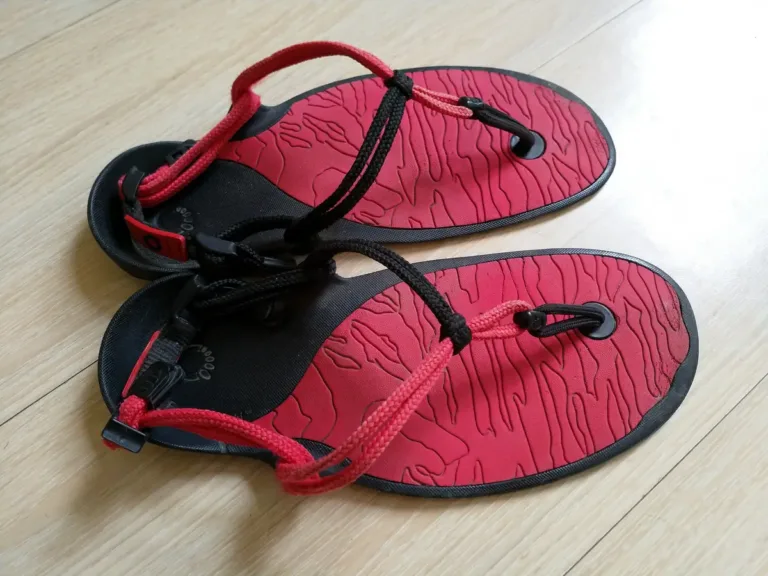
No toe box restriction
A good barefoot sandal should also allow for a wide foot. The feet of humans who spend most of their time barefoot are typically wider than those who wear traditional shoes. A narrow toe box restricts the natural movement of your toes and alters your gait and even your foot shape, narrowing it and causing a higher incidence of deformities such as hallux valgus.
This is where barefoot sandals shine compared to their closed-toe siblings, the barefoot running shoes: Even zero-drop running shoes often have restrictive, narrow toe boxes which don’t let your toes splay they way they evolved to.
Barefoot sandals on the other hand, especially wide barefoot sandals and styles such as huaraches and thong sandals, have little or no sideways restriction at the front of your foot at all. This allows your toes to spread out naturally as you walk or run, improving your balance and stability:
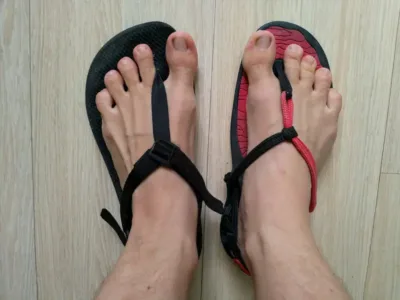
Lightweight
Barefoot sandals should also be lightweight. Heavy shoes can alter your gait and make walking or running more tiring – after all, lifting the weight of your feet at every step really adds up. A lightweight sandal, on the other hand, allows you to move more freely and naturally.
Good fit
Finally, a good barefoot sandal should fit well. Think about how you have to alter your gait when wearing flip flops or slides just to keep them on your feet. That’s exactly what you don’t want with a barefoot sandal.
A good barefoot sandal should stay securely on your foot without requiring you to walk weird. Extra points go to sandals with soles that move with your foot even while it’s in the air, such as huaraches. If the sole bends well only while you roll your foot, but hangs down off the front of your foot before you set it down, you still need to alter your gait to avoid tripping over it.
The perfect hiking sandal lets you walk as if the sole wasn’t even there. Like this:
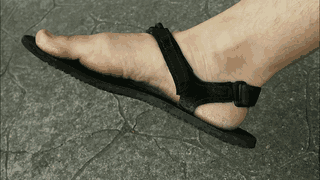
Are barefoot sandals good for you? Pros and Cons.
The scientific literature on this topic is still somewhat underdeveloped. (Which is to be expected – who is going to fund research to show that wearing less shoe will make you healthier? I recently learned that apparently even shoe companies who profited off the barefoot movement tried to simultaneously kill it off for the sake of greater profit with traditional shoes. As a scientist myself, this bias of studies getting funding if companies are likely to benefit off the results greatly annoys me. There is a Coca-Cola funded paper that shows that “sugar doesn’t lead to obesity”. ARGH.)
That tangent aside – the below is supported by my own and my friends’ experiences, and I shall refer to scientifc papers where they are available.
Are zero drop sandals good for your knees?
You might think that zero-drop sandals, with their lack of typical heel cushioning, could be bad for your knees. However, the opposite is actually true. Traditional shoes with elevated heels encourage a heel-strike pattern when you walk or run, which leads to an increased impact on your knees. Zero-drop uncushioned sandals, on the other hand, promote a more natural gait, and reduce this impact.
You can try this out yourself: Stand on one leg, and pretend you’re taking a step landing on the heel of your other foot. Your foot lands way in front of you, with your knee pretty straight, right? And because it does that, all the forward momentum you put into that step is countered by your front foot applying a forward force into the ground, slowing you down. And where does all this extra force go? Your knees, that’s where.
Now, do the same, but put your foot down flat. You don’t want to fully land on your forefoot/toes, that’s too much. Just put your foot down flat, with the outside of your mid-foot touching the floor a split moment before the rest. You’ll find that your foot is automatically much closer to you, more underneath your center of mass, and your knee is more angled. This means that, the moment your foot touches the ground, you are already able to apply force backwards through your foot speeding you up. Much easier on the knees!
Plus, in well-cushioned shoes, people tend to “stomp” into the ground harder to make up for the lack of stability. This can increase the impact on your joints, potentially leading to knee pain and injury. Once you get used to zero-drop sandals or shoes, they can actually be much better for your knees.
Are barefoot sandals good for foot health?
Absolutely! Barefoot sandals help strengthen your feet. When you walk or run in barefoot sandals, your feet have to work harder than they do in traditional shoes. And muscles that work get stronger, improving your foot health over time.
This freedom to move naturally, together with the lack of restriction of the foot, has been shown to reduce the incidence of problems such as flat feet and hallux valgus.
I got a personal story about that: Back when I was wearing normal shoes, I used to be prescribed inlays for my flat feet. I suppose they felt better than not having them, but my feet stayed flat as ever.
After I got rid of the shoes and inlays, and transitioned to barefoot walking (first without then with sandals), I didn’t feel the need to go see a podiatrist for a couple of years. Meanwhile, my feet adapted to the new way of moving.
Recently I went to the doctor for a different issue and, lo and behold – he told me that my arches are too high, and I should get inlays for that. Hehe. Yeah, I don’t think I will. My arches work great. In fact, I can make them high or flat at will now!
Can walking barefoot improve posture?
Walking barefoot, or in barefoot sandals, can indeed improve your posture. When you walk barefoot, your body has to rely more on your muscles for support, rather than the artificial support provided by shoes. This can help strengthen your muscles and improve your balance, both of which can lead to better posture.
Is walking barefoot better than sandals?
If your goal is to achieve the most natural gait possible, then yes, walking barefoot is better than wearing sandals. However, the ground can be dirty, spiky, or hot enough for a high-stakes game of “the ground is literally lava”, which makes barefoot walking uncomfortable or even dangerous in some situations.
Barefoot sandals can provide a good compromise, offering most of the benefits of barefoot walking with fewer drawbacks. According to a study comparing the kinematics of running barefoot vs. with uncushioned and cushioned minimalist shoes and standard shoes, there is still a significant difference between being barefoot and using uncushioned minimalist shoes, when comparing parameters such as heel strike frequency and joint angles. However, this difference is much smaller than when comparing uncushioned minimalist shoes to standard shoes.
In other words, barefoot sandals only get you most of the way to moving like you are barefoot; but they bring you significantly closer to a barefoot gait than normal, cushioned footwear ever could.
How to transition to barefoot sandals
Transitioning to minimalist sandals is a process that requires patience and gradual adaptation. Just like any form of training, it’s important to start slow and progress in a way that prevents over-training. The length of the transition period can vary depending on your starting point. If you’ve spent most of your life wearing rigid, heavily cushioned shoes, the transition to barefoot sandals might take quite some time.
My advice is to start by wearing your barefoot sandals for short distances in your everyday life. This could be a trip to the grocery store or a walk around the block. You could also try to spend more time barefoot at home. This will allow your feet to start adapting to the new way of moving in a controlled environment.
If you got the attention to spare, try sneaking around while barefoot. Extra unnecessary forces between foot and ground cause extra noises – so the most efficient way of walking barefoot is the quietest.
When you start wearing your barefoot sandals for longer periods, make sure you always have a pair of your normal shoes with you. This way, you can switch back to your normal shoes once your feet start to feel tired. You’ll know it’s time to switch when your foot muscles start to feel sore or when you notice yourself heel-striking in a way that sends an uncomfortable shock up your spine.
As your feet get stronger and more accustomed to the barefoot sandals, you can start to increase the distance and time you spend in them. Just listen to your body and not push yourself too hard too soon. Overdoing it can lead to injuries, which will only set you back in your transition.
In addition to wearing your barefoot sandals, you could also consider doing some foot strength exercises. These exercises can help strengthen your foot muscles and speed up your transition to barefoot sandals. Here and here are some exercises you might find helpful.
FAQs
Can you use flip flops as barefoot sandals?
Flip flops might seem like an inviting, cheap alternative to barefoot sandals, considering they are usually zero-drop. But, they are not ideal for promoting a natural gait: The problem with flip-flops is that you need to alter your foot movement to keep them from falling off, which leads you to drag your foot across the ground just to not lose them. For the same reason, I am not a fan of barefoot slides.
However, I know some people who add a heel strap to their flip flops and use them for hiking and even running. This seems to work well for some madlads, but it wouldn’t be my first choice. Flip-flops are typically not very durable, and might have sharp edges that become really uncomfortable over long distances. Plus, they still don’t allow for the same level of foot movement as a good pair of barefoot sandals.
Can I wear barefoot sandals for running?
Yes, you can! Barefoot sandals are great for running as they allow your feet to move naturally, improving your gait and potentially reducing the risk of injury. Some models, like my beloved Shamma Warriors Maximus, are even made specially for running. However, transitioning from traditional running shoes to barefoot sandals should be done gradually to allow your feet and body to adjust.
Are barefoot sandals suitable for all terrains?
While barefoot sandals can be worn on a variety of terrains, they may not provide as much protection as traditional hiking boots or shoes. So if you expect the ground to be challenging, only use barefoot sandals if you are sure that your feet are strong enough to handle it! If you’re planning to hike on particularly rough or rocky terrain, you might want to opt for a pair of barefoot sandals with a thicker sole for extra protection; super thin soles really make you feel the sharp rock edges.
Can I wear socks with barefoot sandals?
While it’s not the norm, you can wear socks with barefoot sandals if you prefer. Some people find that socks can provide extra comfort, especially during the transition period. However, wearing socks may reduce the barefoot feel and benefits of the sandals.
How do I clean my barefoot sandals?
Most barefoot sandals can be cleaned with a soft brush and warm soapy water. It’s best to let them air dry. Avoid exposing them to direct heat or sunlight as this can damage the material.
How often should I replace my barefoot sandals?
The lifespan of barefoot sandals varies depending on how often you wear them and the conditions you wear them in. The nice thing about non-cushioned soles is that they don’t wear out the same way soft, cushioned soles do, so you can avoid this whole “get new shoes when your soles change shape from being worn through to the cushioning” issue. And there’s no shock absorption to worry about losing!
I generally wear my sandals until they are completely and utterly fallen apart. You should change sandals if worn straps or the like make them uncomfortable to wear – but that has never happened to me with barefoot sandals!
Conclusion
Barefoot sandals offer a more natural way of moving, allowing your feet to strengthen and adapt. They can improve your gait, potentially reduce the risk of injury, and provide a sense of freedom that traditional footwear often lacks.
Transitioning to barefoot sandals requires patience and a gradual approach, but the benefits are well worth it. Whether you’re walking, running, or hiking, barefoot sandals can enhance your experience and bring you closer to the natural world.
So why not take the first step towards a more natural way of moving? Your feet might just thank you for it!

